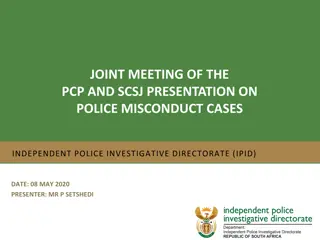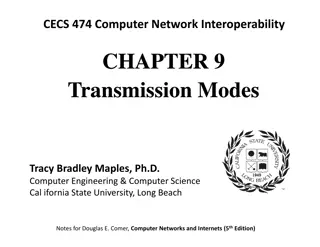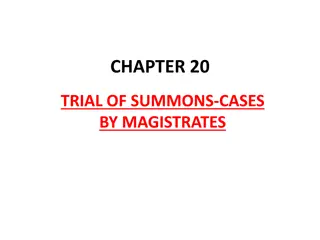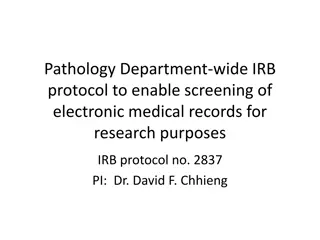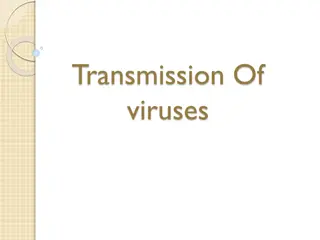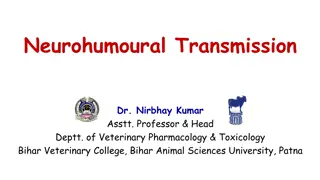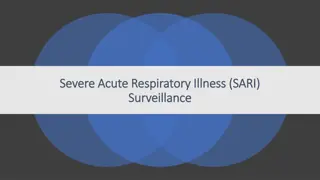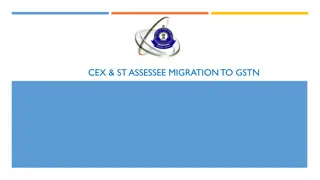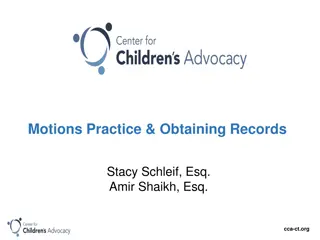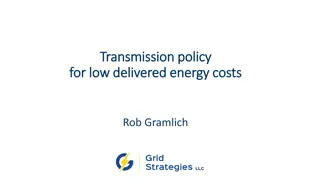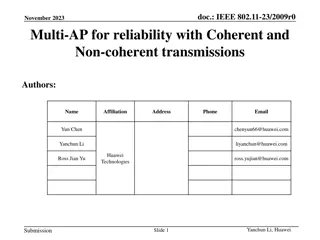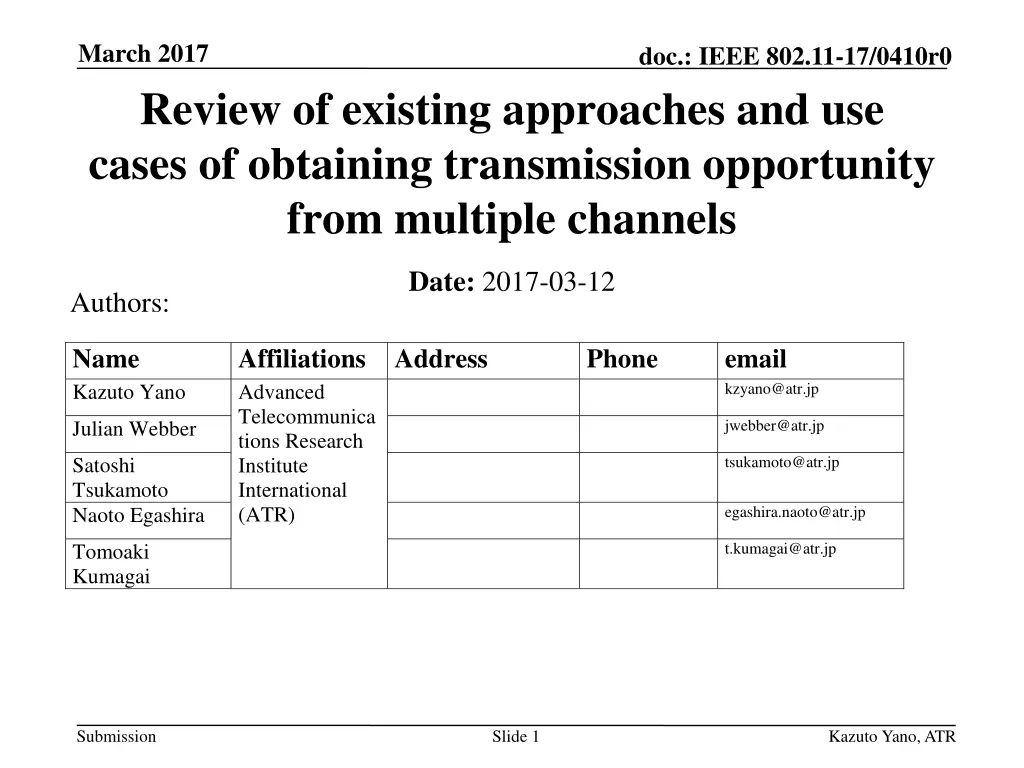
March 2017 Review and Use Cases of Obtaining Transmission Opportunity from Multiple Channels
"Explore the challenges of channel congestion in IEEE 802.11 wireless LAN systems and the need for innovative approaches to improve system throughput. Discover insights on spectrum usage and potential solutions for obtaining transmission opportunities from various channels. Dive into the complexities of channel selection and available resources in busy environments. Stay informed on the latest advancements in enhancing wireless network efficiency and performance."
Download Presentation

Please find below an Image/Link to download the presentation.
The content on the website is provided AS IS for your information and personal use only. It may not be sold, licensed, or shared on other websites without obtaining consent from the author. If you encounter any issues during the download, it is possible that the publisher has removed the file from their server.
You are allowed to download the files provided on this website for personal or commercial use, subject to the condition that they are used lawfully. All files are the property of their respective owners.
The content on the website is provided AS IS for your information and personal use only. It may not be sold, licensed, or shared on other websites without obtaining consent from the author.
E N D
Presentation Transcript
March 2017 Review of existing approaches and use cases of obtaining transmission opportunity from multiple channels doc.: IEEE 802.11-17/0410r0 Date: 2017-03-12 Authors: Name Kazuto Yano Affiliations Address Advanced Telecommunica tions Research Institute International (ATR) Phone email kzyano@atr.jp jwebber@atr.jp Julian Webber tsukamoto@atr.jp Satoshi Tsukamoto Naoto Egashira egashira.naoto@atr.jp t.kumagai@atr.jp Tomoaki Kumagai Submission Slide 1 Kazuto Yano, ATR
March 2017 doc.: IEEE 802.11-17/0410r0 Abstract This presentation: shows an example of spectrum usage in 2.4 GHz unlicensed band measured at a terminal station in Japan, briefly reviews current approaches such as IEEE 802.11aa and 11ai to select a good channel, shows the limitation of above approaches, also shows some use cases in which the new approach is necessary. Submission Slide 2 Kazuto Yano, ATR
March 2017 doc.: IEEE 802.11-17/0410r0 Background (1) The amount of wireless LAN traffic is still increasing. It is forecasted that the amount of the traffic will become four times larger from 2015 to 2020 [1]. Thus, enhancement of system throughput of the wireless LAN is still necessary. Growth of IP traffic forecasted by Cisco [1]. Submission Slide 3 Kazuto Yano, ATR
March 2017 doc.: IEEE 802.11-17/0410r0 Background (2) In current IEEE 802.11 wireless LAN, a BSS sets one primary channel on which each STA invokes the back-off procedure to transmit its data [2]. If the primary channel is congested, the STA hardly transmits its data even if other channels are vacant [3]. In the previous WNG SC session, we presented a new approach to overcome this issue by instantly obtaining transmission opportunity from vacant channels in the same or another frequency band [4]. A comment that IEEE 802.11aa started with this problem by selecting the channel correctly was given for the previous presentation [5]. Submission Slide 4 Kazuto Yano, ATR
March 2017 Issue of congested primary channel on current IEEE 802.11 wireless LAN [3, 4] doc.: IEEE 802.11-17/0410r0 In the current IEEE 802.11 wireless LAN, a BSS sets one primary channel on which each STA invokes the back-off procedure to transmit its data [2]. If the primary channel is congested, the STA hardly transmits its data even if other channels are vacant [3], and such unused resources cannot be available unless changing the primary channel. Another STA cannot transmit its data if the primary channel is busy. busy idle idle idle idle idle ch. a ch. b ch. c ch. d ch. e ch. f primary channel Submission Slide 5 Kazuto Yano, ATR
March 2017 Example of channel usage at a railway terminal station in Japan doc.: IEEE 802.11-17/0410r0 In some busy locations, radio channels are heavily congested. The congestion will become more severe in future. time time 500 ms 30 min. ch. 1 ch. 6 ch. 11 ch. 1 ch. 6 ch. 11 Spectrogram of 2.4 GHz band measured in a rush-hour at a railway terminal station in Japan. Submission Slide 6 Kazuto Yano, ATR
March 2017 doc.: IEEE 802.11-17/0410r0 Possible approaches to overcome this issue An AP selects a channel with enough available resource by using QLoad Report for management of OBSS defined in IEEE 802.11aa [6]. A non-AP STA searches a BSS with enough available resource by channel scanning and quickly sets up a link to the BSS by FILS defined in IEEE 802.11ai [7]. A STA instantly obtains transmission opportunity on another idle channel even when the primary channel is busy by performing CCA in parallel on multiple channels. (new approach) Submission Slide 7 Kazuto Yano, ATR
March 2017 doc.: IEEE 802.11-17/0410r0 Using OBSS management in IEEE 802.11aa [6] IEEE 802.11aa defines a procedure to manage OBSS by using QLoad Report. It includes several information related with channel sharing policy, the number of allocated streams of QoS traffic, amount of peak QoS traffic, and so on. IEEE 802.11aa also shows some examples of channel selection procedure using the QLoad Report for efficient resource sharing among BSSs. Resource Total available resource load Channel selection own load AP in OBSS own OBSS load OBSS load OBSS load AP AP in OBSS ch. ch. a ch. b ch. c Submission Slide 8 Kazuto Yano, ATR
March 2017 doc.: IEEE 802.11-17/0410r0 Using FILS in IEEE 802.11ai [7] IEEE 802.11ai provide FILS to minimize initial link setup time. If a non-AP STA obtains BSS load information from several BSSs by channel scan and sets up a link to a BSS with a low load, an overload situation might be avoided. AP (BSS 1) AP Resource (BSS 2) Total available resource Selected BSS 1 load AP BSS 2 load BSS 3 load (BSS 3) ch. ch. a ch. b ch. c Submission Slide 9 Kazuto Yano, ATR
March 2017 doc.: IEEE 802.11-17/0410r0 Benefit of current approaches When channel loads are imbalanced among channels, QoS can be improved by switching the primary channel from congested one to idle one by the current approaches. As many STAs taking these approaches, average channel load will be more balanced among channels. Channel selection based on measured channel load Resource Total available resource Measurement of average channel load BSS 4 BSS 5 BSS 3 BSS 1 BSS 2 ch. 1 ch. 6 ch. 11 ch. a ch. b ch. c Submission Slide 10 Kazuto Yano, ATR
March 2017 doc.: IEEE 802.11-17/0410r0 Limitation of current approaches The current 11aa and 11ai s approaches will balance channel loads among channels. On the other hand, the total channel load is getting raised as the amount of traffic and the number of wireless LAN terminals increases. When the channel load is relatively high, another approach will be necessary to further improve the QoS to meet the user s demand. Submission Slide 11 Kazuto Yano, ATR
March 2017 doc.: IEEE 802.11-17/0410r0 Short-term channel usage In a short time, there are some unused periods on a channel unless the channel is full-loaded. These unused periods randomly and independently occur among channels even after the channel load is balanced. QoS of each traffic will be improved if such unused periods are available. ch. 1 ch. 6 Submission Slide 12 Kazuto Yano, ATR
March 2017 doc.: IEEE 802.11-17/0410r0 Another approach [4] To utilize unused periods which occur randomly and independently in multiple channels, a STA performs CCA and the backoff process on multiple channels in parallel to quickly obtains transmission opportunity on an idle channel. This approach will be effective whether channel load is balanced or not. Utilize these idle resources scattered in multiple channels for channel access. ch. 1 ch. 6 Submission Slide 13 Kazuto Yano, ATR
March 2017 doc.: IEEE 802.11-17/0410r0 Use case of the new approach (1) By employing the new approach, a STA can obtain more transmission opportunities, and thus achievable throughput will be increased. This approach will enhance the robustness of QoS support to QoS traffic in relatively high-load situations whether or not the average channel load is balanced by current approaches. This new approach would be more effective when there are many unmanaged BSSs, for example, in a condominium building or a public space where many mobile routers are operated. Submission Slide 14 Kazuto Yano, ATR
March 2017 doc.: IEEE 802.11-17/0410r0 Use case of the new approach (2) Transmission delay will be reduced by the new approach. It will help to support QoS traffic with severe requirement on latency. ch. ch. a Busy Backoff Transmission (primary channel) Reduced transmission delay ch. b Busy Backoff Transmission (another channel) Time Kazuto Yano, ATR Submission Slide 15
March 2017 doc.: IEEE 802.11-17/0410r0 Summary (1/2) IEEE 802.11aa defines a procedure to manage OBSS. By using this, efficient resource sharing among BSSs is enabled. If a STA finds another BSS with enough available resource, and quickly sets up a link to the BSS by FILS defined in IEEE 802.11ai, the overload situation might be avoided. On the other hand, the total channel load is getting raised as the amount of traffic and the number of wireless LAN terminals increases. When the channel load is relatively high, another approach will be necessary to further improve the QoS to meet the user s demand. Submission Slide 16 Kazuto Yano, ATR
March 2017 doc.: IEEE 802.11-17/0410r0 Summary (2/2) The new approach obtains transmission opportunity on a idle channel by performing CCA on multiple channels in parallel. This approach will enhance the robustness of QoS support to QoS traffic in relatively high-load situations whether or not the average channel load is balanced by current approaches. This new approach would be more effective when there are many unmanaged BSSs. Submission Slide 17 Kazuto Yano, ATR
March 2017 doc.: IEEE 802.11-17/0410r0 Straw Poll #1 Do you agree that there are issues in balanced and relatively high-load situations, and it is hard to overcome only by existing approaches in IEEE 802.11 wireless LAN in some cases? Y: N: Need more information Don t care Submission Slide 18 Kazuto Yano, ATR
March 2017 doc.: IEEE 802.11-17/0410r0 Straw Poll #2 Do you think that IEEE 802.11 wireless LAN should have a new way to overcome some relatively high-load situations? Yes No Need further study/information Don t care Submission Slide 19 Kazuto Yano, ATR
March 2017 doc.: IEEE 802.11-17/0410r0 References [1] Cisco, Cisco Visual Networking Index: Global Mobile Data Traffic Forecast Update, 2016 2021, Cisco White Paper C11-738429-00, February 2017. [2] IEEE 802.11-2012. [3] doc. IEEE 802.11-14/1437r1. [4] doc. IEEE 802.11-17/0129r3. [5] doc. IEEE 802.11-17/0146r0. [6] IEEE 802.11aa-2012. [7] IEEE 802.11 TGai D10.0. Submission Slide 20 Kazuto Yano, ATR


